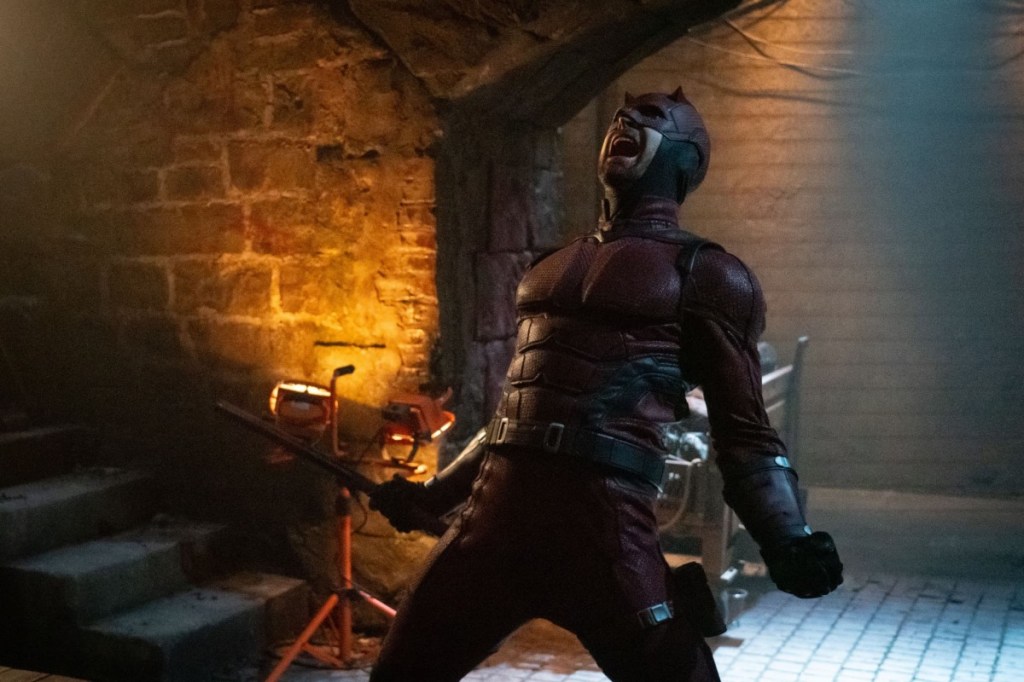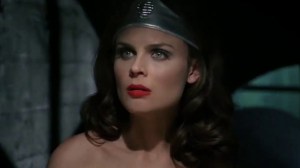Disney+’s Daredevil: Born Again brings The Man Without Fear back to protect Hell’s Kitchen, and builds upon the standards of Netflix’s original Daredevil series in several important ways. Upon its debut in 2015, Daredevil served as the Iron Man of the Marvel-Netflix era, becoming a hugely popular streaming hit and paving the way for its fellow series Jessica Jones, Luke Cage, Iron Fist, The Punisher, and The Defenders (the latter a crossover series featuring all of Netflix’s Marvel heroes, save for The Punisher). It’s been a long wait since the end of the Marvel-Netflix era for Daredevil to return, but after a handful of MCU cameos as either a “really good lawyer” or a street-level crime-fighter fighter, Charlie Cox’s Matt Murdock finally made his long-awaited return in what is, for all intents and purposes, Daredevil Season 4, Daredevil: Born Again.
Videos by ComicBook.com
With Born Again‘s Season 1 finale in the books, and ending on a jaw-dropping cliffhanger (literally) for Daredevil: Born Again Season 2, comparisons with Matt’s original series began as soon as the MCU reboot debuted, with the elevated and highly cinematic scope of the show being a standout from the original Daredevil – but that’s just the beginning.
Here are three major ways that Daredevil: Born Again improves upon Netflix’s Daredevil.
Daredevil: Born Again Completely Takes the Gloves Off with Blood & Gore

It’s easy to forget just how much of a yin-and-yang contrast Daredevil – and for that matter, all of Marvel-Netflix – was from the MCU proper. With much more adult themes and content, gritty crime-based villain plots, and far more intense fight scenes than their big-screen counterparts, Marvel-Netflix was a genuine equivalent to an R-rated corner of the MCU, even though it was never properly welcomed under the MCU umbrella at the time. Daredevil led the way in establishing the Marvel-Netflix template with a much darker tone and more intense action than anything being showcased by Marvel Studios movies.
With The Man Without Fear, and by extension all of Marvel-Netflix, having since been officially integrated into the MCU continuity, Daredevil: Born Again doesn’t simply maintain the degree of R-rated power of its Netflix predecessor – it goes out of its way to surpass it. Remember when the Kingpin decapitated an enemy’s head with a car, and how shocked the world was, even though it was mostly shrouded in shadow? On Daredevil: Born Again, Vincent D’Onofrio’s Wilson Fisk outright crushes a man’s head with his bare hands in full view of the camera, and that’s just one snippet of how unrestrained the show is in how harsh it gets.
Daredevil’s first fight scene with Bullseye in the show ends with Matt standing with eight knives protruding from his torso, while Born Again’s fight scenes regularly see those on the losing end writhing in pain from facial contusions and compound fractures. And that’s without bringing up the quantity of F-bombs thrown about like confetti in all directions – including the big turning moment where Matt says “F*ck it,” and decides to resume his work as Daredevil. With Daredevil moving under the proper Disney banner and landing on Disney+ for his continuation series, there was certainly a valid concern among fans of Netflix’s Daredevil that the show’s intensity and willingness to embrace adult-oriented, R-rated material would not carry over. After the end of Daredevil: Born Again‘s first season, it’s fair to say those concerns are dead as a doornail.
RELATED: Daredevil: Born Again: Is [SPOILER] Really Dead?
Vanessa Fisk Is More Evil Than Ever (and a More Individualized Character)

The return of Vincent D’Onofrio as the Machiavellian Kingpin on Daredevil: Born Again also brings with him the return of his wife Vanessa Marianna-Fisk (Ayelet Zurer) after their marriage on Season 3 of Netflix’s Daredevil. In her role on the show’s first and third seasons, Vanessa was presented as somewhat of a normal person infected by Fisk’s influence in their initial courtship, and who gradually goes from an onlooker of his criminal activities to an accomplice. Evidently, Vanessa’s soul has darkened enough to match the viciousness of her husband when they meet again on Daredevil: Born Again.
When Born Again opens, Vanessa is revealed to have grown into a legitimate New York City crime boss herself, with her reputation preceding her to the same extent as her husband’s did. Zurer also presents Vanessa as a much colder crime boss than her husband, able to orchestrate her plans with a precision that exposes just how much more volatile Fisk’s own methods and temperament are. Moreover, Vanessa engaged in an extra-marital affair with a New Yorker named Adam (Lou Taylor Pucci) during Fisk’s incarceration with no visible concern over how her ruthlessly violent husband would react, and she shows complete indifference when she herself murders Adam to preserve her and her husband’s safety and maintain their marriage. Compared to the vaguely but increasingly sinister Vanessa seen on Netflix’s Daredevil, the Vanessa of Daredevil: Born Again has graduated to a calm but calculating rival to the Kingpin himself.
Daredevil & Punisher Feel Even More Believable as a Reluctant Duo

Season 2 of Netflix’s Daredevil brought Jon Bernthal’s Punisher into play as an ideological contrast to Matt Murdock. Accordingly, Matt’s reluctance to take lives runs up against Frank’s view that letting criminals live simply sets them up to prey on society again. Daredevil Season 2 presented a terrific dichotomy of Daredevil and the Punisher as enemies who are eventually forced to team up, with their methods causing considerable friction between the two, even as Matt briefly contemplates indulging Frank’s predilection for killing (Matt crossing himself at the prospect with his own Catholic faith guiding his vigilantism). In the end, Matt and Frank understand they just can’t work together by the end of Daredevil Season 2, with Frank departing with a farewell of, “See you around, Red.”
While that seemed like the perfect place to leave the Daredevil-Punisher partnership for good, Daredevil: Born Again re-unites Matt and Frank in a manner that is both organic to the story and occurring under circumstances in which Matt could plausibly consider another team-up with Frank, specifically the aftermath of the murder of his best friend and business partner Foggy Nelson (Elden Henson). Born Again’s first scene of Matt and Frank meeting shifts from the philosophical debate of their methods in their immortal rooftop scene to one predicated entirely on emotion and the tragedies both men have endured. More than ever, Matt has a hard time rebutting Frank’s assertion that sparing the lives of mobsters and criminals only makes tragedies like Foggy’s that much more likely, the pair’s scene really driving home the gut punch of Foggy’s killing by Bullseye.
Daredevil and Punisher are once again forced to join forces in Born Again‘s Season 1 finale, but the circumstances are even more believable than their initial team-up in Daredevil Season 2 had been. While Matt had been been trying to reign Frank in and at least paid lip service to the idea of using his lethal methods in the vain hope of walking him back from them, Matt’s bitterness over Foggy’s murder makes his second team-up with Frank much more personal as that of a man battling within himself over whether moving into using lethal force is a way to atone for his failure to save Foggy, even as he keeps trying to stop Frank from killing.
The Daredevil seen joining forces with Punisher in Daredevil: Born Again is a man far more broken on the inside than he was on Daredevil Season 2, and therefore more likely to contemplate a partnership with him, even as he questions it to himself the entire time. While the Daredevil-Punisher conflict/team-up on Daredevil Season 2 was by no means a letdown, Daredevil: Born Again actually finds a way to believably build upon it and make it more philosophically and even spiritually tense than ever.
All three seasons of Netflix’s Daredevil and Daredevil: Born Again are available to stream on Disney+.








